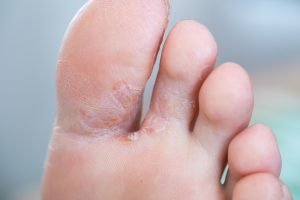Athlete’s Foot, also called tinea pedis, is a fungal infection of the foot. This It is a type of fungus that thrives in an environment that is warm, dark, and moist, similar to the inside of a shoe. It is commonly seen in athletes who walk barefoot in locker rooms but it can affect anyone. Even though it isn’t a serious disease, it can be quite uncomfortable and can be difficult to cure.
Athlete’s foot is spread by coming into direct contact with someone who already has it (wearing shoes or socks of an infected person), or indirectly (by walking on surfaces in a locker room, around a pool, or in a shower where someone with the infection has been).
Symptoms of athlete’s foot include:
- Blisters on the feet that itch
- Burning, itching, and stinging in the areas between the toes or on the soles of the feet
- Discolored toe nails
- Raw skin on the bottom of the feet
- Peeling skin on the bottom of the feet
- Having bad foot odor
Prevention of athlete’s foot is very important, especially if using public locker rooms or showers. Some of the methods of prevention include:
- Wearing water slippers in public showers and locker rooms
- Never walking barefoot
- Never wearing someone else’s shoes, socks, or towels
- Changing socks frequently especially if you sweat a lot
- Using antifungal powder every day
- Washing your feet with soap and water every day and drying them well, especially between the toes
- Disinfecting the inside of your shoes with disinfectant wipes
- Never wearing shoes that are damp on the inside
Athlete’s foot is diagnosed by taking a skin scraping form the infected area and placing it in a solution of potassium hydroxide. It is then examined under a microscope. If the sample is positive the normal cells will have dissolved and the infected cells will remain.
Treatment of athlete’s foot requires medication which can either be a topical over the counter medication or a stronger topical agent that will be prescribed by a physician. Sometimes an oral medication may be necessary if the infection is very serious.
If you are experiencing any of the symptoms of athlete’s foot you should seek medical care right away. If you would like to schedule an appointment with a foot doctor at Flushing Hospital Medical Center, please call 718-670-5486.
All content of this newsletter is intended for general information purposes only and is not intended or implied to be a substitute for professional medical advice, diagnosis or treatment. Please consult a medical professional before adopting any of the suggestions on this page. You must never disregard professional medical advice or delay seeking medical treatment based upon any content of this newsletter. PROMPTLY CONSULT YOUR PHYSICIAN OR CALL 911 IF YOU BELIEVE YOU HAVE A MEDICAL EMERGENCY.


